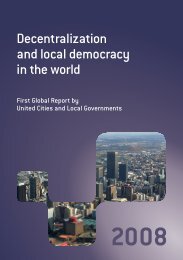Making Cities Resilient Report 2012
Making Cities Resilient Report 2012
Making Cities Resilient Report 2012
Create successful ePaper yourself
Turn your PDF publications into a flip-book with our unique Google optimized e-Paper software.
CHAPTER 4 | What are local governments doing to build resilience<br />
Early warning and risk communication<br />
Several cities have worked on introducing or upgrading early warning networks, including Cairns; San<br />
Francisco, Cebu; North Vancouver; Chacao; Ancona; and Pune, to allow organisations and households<br />
sufficient time to get to a place of safety. An integrated early warning system in Chacao uses a wireless<br />
system to connect civil protection and environmental institutions to cameras that are monitoring four river<br />
channels crossing the city (55).<br />
Some cities undertake pre-emptive evacuations of high-risk areas to ensure the population is not exposed<br />
to an imminent hazard – an approach that has contributed to a zero-casualty rate in Albay Province over<br />
the past 16 years (excluding 2006). Albay Province’s local government uses a decision-tree model to decide<br />
on the appropriate moment to take this costly yet life-saving response.<br />
The clarity and speed of risk communication information among scientists that monitor hazard data,<br />
government actors responsible for making decisions based on this information, and the public, is critical<br />
to the effectiveness of emergency response. Johannesburg identified a lack of closeness among these<br />
groups as a barrier to effective emergency response.<br />
Some cities use online resources to communicate hazard warnings. In Chacao, real-time hazard information<br />
is available online so people can keep abreast of changes when disasters occur (55). Other cities use<br />
mobile phones to help disseminate hazard warnings quickly. In Albay Province, an organisation called<br />
Infoboard distributed SIM cards to village officials (45). In Cairns, citizens receive emergency alerts through<br />
the National Emergency Warning System via landline and mobile phones. But in advance of receiving<br />
these warnings, individuals must have a clear idea of how to respond. To this end, Cairns has produced<br />
evacuation guides that are available online and Saijo City has produced a map showing the areas that are<br />
projected to become submerged, with escape routes and the location and capacities of evacuation sites.<br />
Risk communication is more challenging in contexts with limited resources and telecommunications<br />
infrastructure, such as Kampala, where there is currently no communication plan. In Moshi, if a disaster is<br />
imminent, the Council sends cars around the city to disseminate warnings via loud speakers and broadcasts<br />
warnings on local radio stations. Because there is no official hazard notification process in Pakistan, the<br />
mass media plays a critical role in disseminating risk warnings (62).<br />
10. Recovery and Rebuilding<br />
Communities<br />
Essential 10: After any disaster, ensure that the needs of the affected population are placed at the centre<br />
of reconstruction, with support for them and their community organisations to design and help implement<br />
responses, including rebuilding homes and livelihoods.<br />
Work structured around this Essential and accumulated over the last 30 years has shown how important<br />
recovery and rebuilding activities are – both in terms of helping affected individuals and communities to<br />
take action and in terms of producing solutions that meet their needs.<br />
Good recovery practices also have a direct link to reconstruction activities that have risk reduction and<br />
larger development objectives. Disaster response becomes an opportunity to improve previous conditions.<br />
One way that cities are doing this is to link recovery plans and policies with larger city development<br />
planning. During reconstruction following the earthquake, Santa Tecla developed a long-term plan for<br />
future development, through a series of public debates, which included the concept of disaster risk<br />
reduction 15 . In Chincha, Pisco, Canete and Ica, Peru, following the 2007 earthquake, local governments<br />
worked to integrate recovery into overall development and risk reduction. This entailed work on a range<br />
of issues, including updating and redesigning the municipalities’ development plans to make them more<br />
<strong>Making</strong> <strong>Cities</strong> <strong>Resilient</strong> <strong>Report</strong> <strong>2012</strong> | 63

















